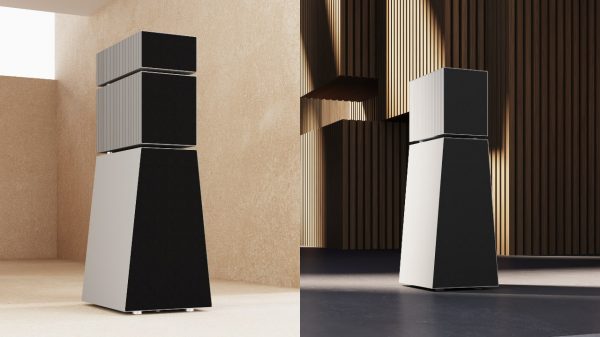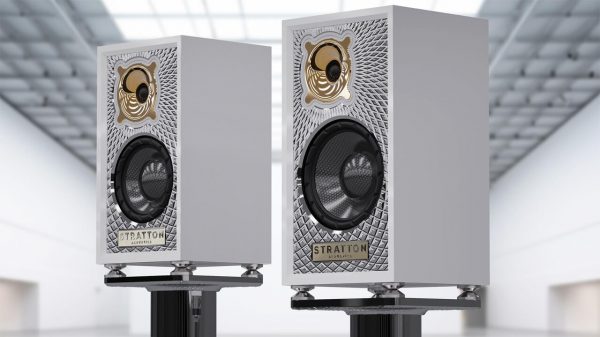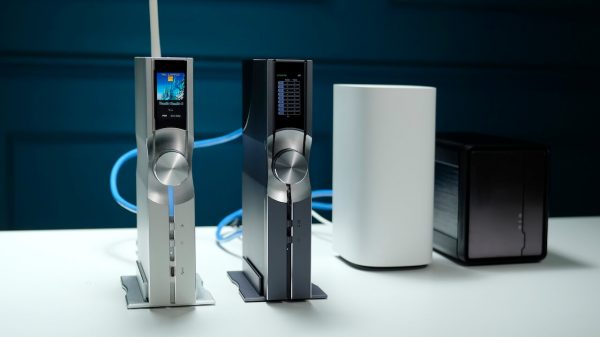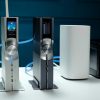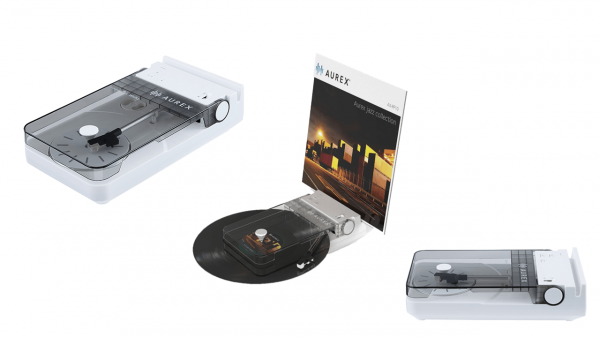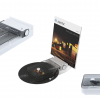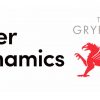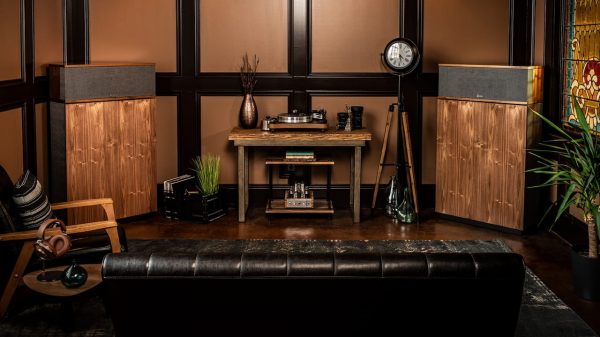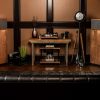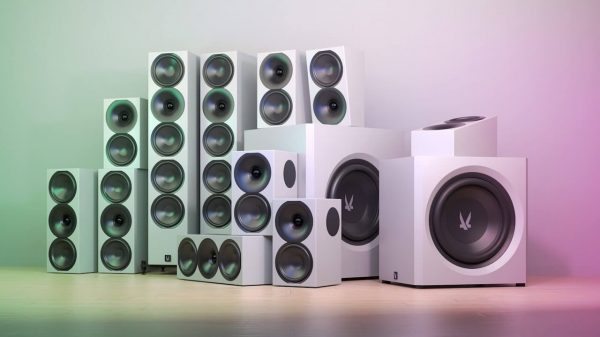If you still think the future of high-end audio lies in large rack systems with multiple components—think again. Active and wireless loudspeakers are set to lead the next generation of premium audio systems. Goldmund is a Swiss audio manufacturer renowned for crafting ultra-luxurious, large-scale loudspeakers that are well beyond the reach of most audio enthusiasts. Take their flagship Gaia active loudspeakers, for instance—standing nearly seven feet tall with a price tag around half a million dollars.
Building on the success of its flagship Gaia wireless active loudspeaker, Goldmund unveiled a smaller, similarly designed line of wireless speakers featuring built-in powered subwoofers. The new models—Theia, Rhea, and Asteria—offer impressive features, though even the most affordable option is priced higher than a Tesla Model S Plaid.
Their newest offerings, the Goldmund Rhea Passive and Theia Passive, maintain the brand’s commitment to high-end craftsmanship. While these models may not match the Gaia in both size and cost, they’re still impressive and likely out of reach for most audio lovers — unless you’re fine with spending as much as a condo (1990s prices) for either pair.
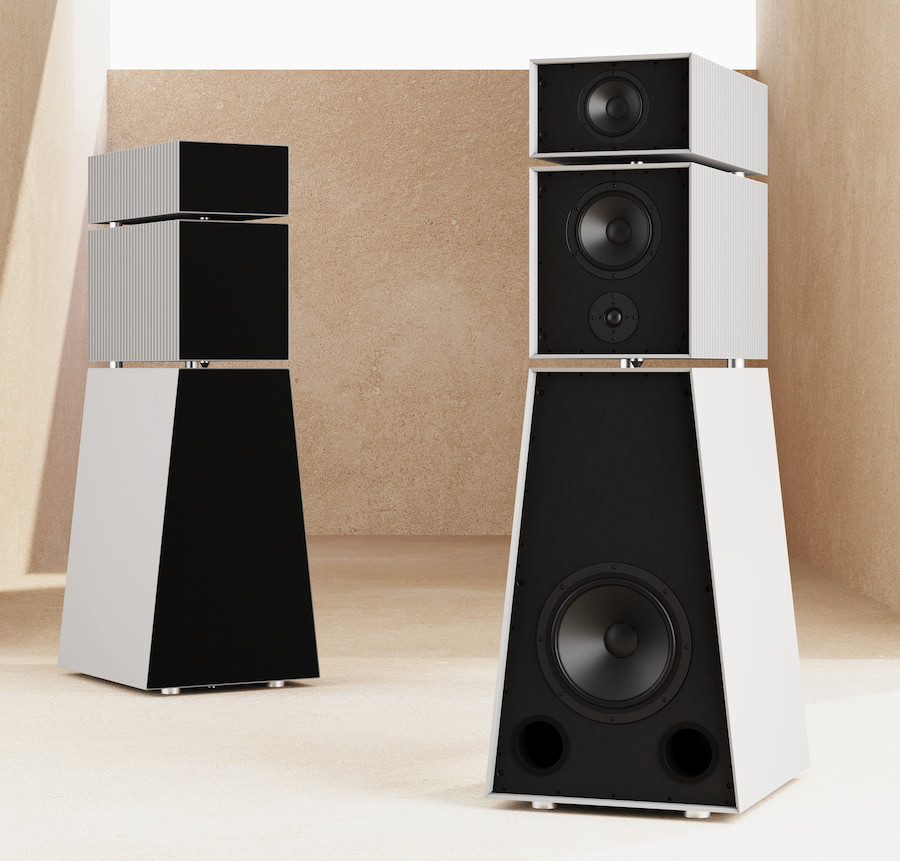
Striking Industrial Design
The first thing that grabs your attention is their striking presence. The Theia Passive and Rhea Passive blend seamlessly into any space, their sleek, sculptural forms exuding an air of refined sophistication. Every detail is carefully crafted, ensuring these speakers don’t just serve as audio devices, but as works of art—art that, of course, costs more than your grandma’s condo in Miami Beach.
Goldmund’s obsession with precision shows in every detail. The cabinets are assembled with invisible seams for a flawless finish, and each panel is joined at a perfect 45° angle—because why settle for less when you can achieve seamless perfection?
The wavy side panels catch the light, creating depth and drama, while the dual-finish aluminum exterior—micro-blasted vertically and brushed horizontally—adds that extra touch of architectural elegance. The standard finish is a refined gray body with black grids, though if you want the black version, you’ll need to cross your fingers and hope it’s in stock. After all, art like this doesn’t come cheap.
The substantial mass of the Theia Passive and Rhea Passive, coupled with Goldmund’s proprietary mechanical grounding construction, directs unwanted vibrations to the ground through a precisely engineered tip. This ensures absolute purity in sound reproduction, keeping the audio as clean and undisturbed as the price tag.
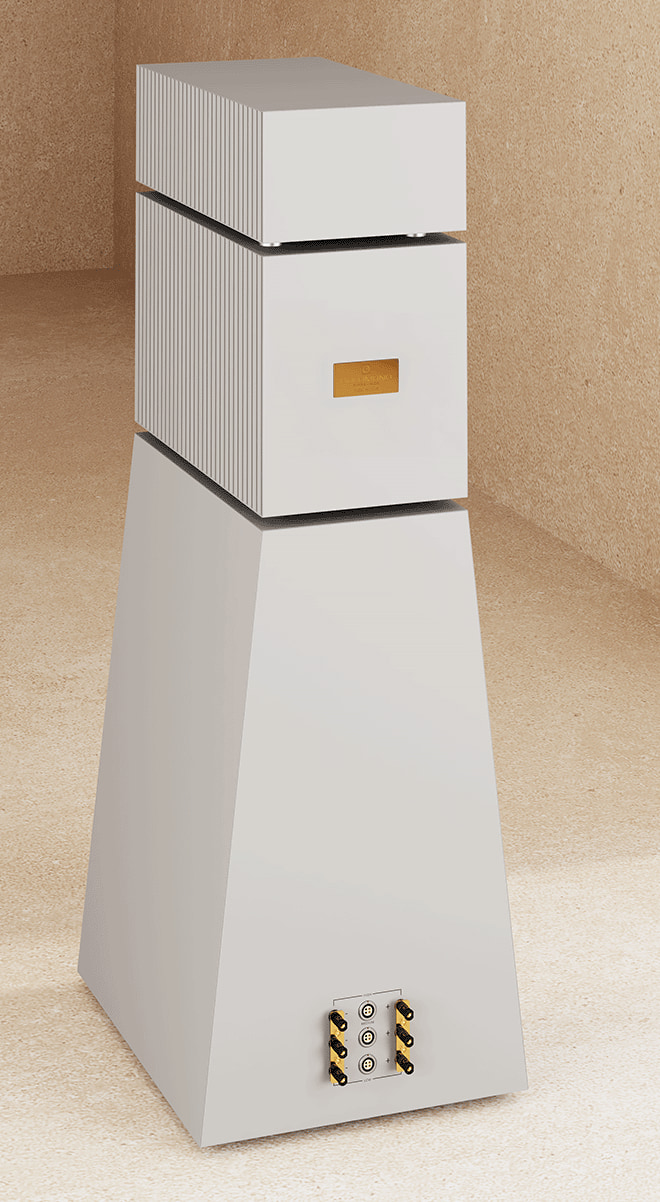
Fusion of Art & Sound
While the Rhea Passive and Theia Passive share a similar visual design and Goldmund’s mission to “redefine sonic realism,” they differ significantly in configuration and technical execution.
The Rhea Passive is a three-way passive loudspeaker featuring a soft dome tweeter, a single 7-inch midrange driver, and a 12-inch woofer. In contrast, the Theia Passive employs a four-way design, incorporating a soft dome tweeter, dual midrange drivers (a 4-inch and a 6-inch), and the same 12-inch woofer. This additional midrange layering in the Theia enables finer resolution and smoother transitions across the frequency spectrum.
In terms of frequency response, the Rhea Passive is rated from 27Hz to 25kHz, delivering deep bass and extended highs, while the Theia Passive pushes even lower, reaching 20Hz—ideal for reproducing the full impact of sub-bass content without requiring external support.

Advanced crossover design ensures seamless frequency integration, delivering a wide, immersive soundstage with precise balance and dispersion. Each driver has its own dedicated crossover board, built with premium components like MKP capacitors and non-inductive film resistors—each thermally managed with custom heat sinks to maintain performance under demanding conditions.
The free air-core inductors, made from ultra-thick, pure oxygen-free copper, deliver outstanding linearity and ultra-low distortion. To eliminate vibration-related interference, Goldmund uses a carefully engineered combination of PCB mounting and mechanical reinforcement.
Each passive component is built with power ratings far beyond what they’ll ever see in use, ensuring that even the most extreme voltage or current spikes won’t cause saturation or compromise performance.
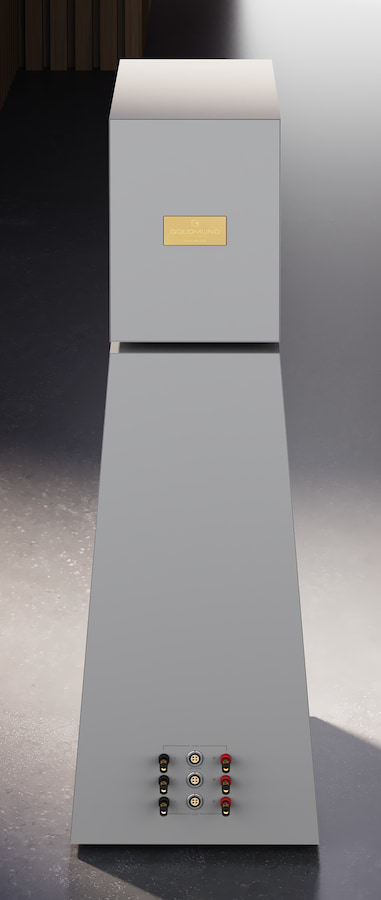
Weighing over 123 kg per cabinet, each Rhea Passive speaker anchors itself with serious authority. Goldmund’s proprietary mechanical grounding system channels unwanted vibrations away from the cabinet, ensuring nothing gets in the way of pure, uncolored sound.
The larger Theia Passive tips the scales at over 197 kg per speaker, so you’ll want to make sure your floor is as committed to high-end audio as you are. A sturdy foundation isn’t just recommended—it’s essential if you’d prefer your speakers stay put and your home remains intact.
Nuclear Power Plant Handy?
Driving the Rhea Passive and Theia Passive isn’t a job for your average integrated amp—they demand serious power and control to perform at their best. With their large, multi-driver configurations and incredibly detailed crossovers, these behemoths need high-current, high-resolution amplification to truly shine. Think reference-grade monoblocks or a beefy Class AB powerhouse with ample headroom.
Anything less, and you’re just scratching the surface of what they can do. If you’re investing six figures in speakers, skimping on amplification isn’t just a bad idea—it’s a betrayal.
When it comes to power amplifiers, Goldmund doesn’t exactly do “subtle”—and it definitely doesn’t do “affordable.” In 2024, we reported on the Telos 690 Integrated Amplifier and the 800 Stereo Power Amplifier, both packing serious performance and equally serious price tags. Despite a wobbly global economy, brands like Sonus faber, Gryphon, and Goldmund seem laser-focused on releasing six-figure gear for the ultra-committed—or ultra-rich—few.

Case in point: the new Goldmund Telos 4800 mono power amplifiers, which can clean out your savings faster than you can say “audiophile dream.” Inspired by the flagship 8800 mono blocks from 2023, the 4800s are engineered to muscle through even the most stubborn, low-impedance speaker loads without breaking a sweat—or your soundstage.
First, let’s talk raw power. With a maximum output of 1050 watts RMS at 8 ohms, the Telos 4800 has more than enough juice to handle the Theia’s complex four-way configuration or the Rhea’s three-way design. That kind of headroom means you won’t just hear your music—you’ll feel it, with effortless dynamics and zero strain, even at concert-level volumes.
And thanks to a total harmonic distortion (THD) of just 0.005% across the entire 20 Hz to 20 kHz range, the sound remains impeccably clean and precise no matter how hard you push it.
The 117 dB dynamic range, measured with a 22 kHz bandwidth, ensures that the amplifier captures every nuance, from the quietest micro-detail to the most explosive crescendo. Whether you’re listening to a delicate jazz trio or a Mahler symphony, the 4800 preserves all the drama and subtlety in the performance. Combine that with a damping factor of 600 at 1 kHz, and you get bass that’s not just deep, but tightly controlled—something that’s critical when you’re powering speakers with massive 12-inch woofers.
Noise floor? Practically nonexistent. With output floor noise below 3 μV, the 4800 ensures pitch-black backgrounds that let your recordings shine without interference or hum. And because system matching matters, the gain is adjustable in 3 dB increments, giving you the flexibility to tailor the output to your preamp and room.
Lastly, Goldmund’s attention to detail inside the chassis is just as obsessive as what you see on the outside. The Telos 4800 features their proprietary MKP silver-metalized polypropylene film capacitors and a massive copper ground plane, providing robust energy storage, minimal signal loss, and consistent performance under demanding loads.
In short, if you’re investing in Goldmund’s flagship passive loudspeakers, pairing them with the Telos 4800 isn’t just a recommendation—it’s practically a requirement. Anything less might be like putting economy tires on a Formula 1 car.
The Bottom Line
The Goldmund Theia and Rhea Passive speakers are for audiophiles with wallets the size of small countries. Their performance is unmatched, but so is their price—think GDP of a small African nation territory. Pair them with the Goldmund Telos 4800, and you’ve got the ultimate audio setup, assuming you can somehow bypass tariffs, cost of living, and maybe your next mortgage payment. If you’re ready to drop six figures for sound that could reshape your world, these speakers won’t disappoint—but don’t expect to walk away with any change.
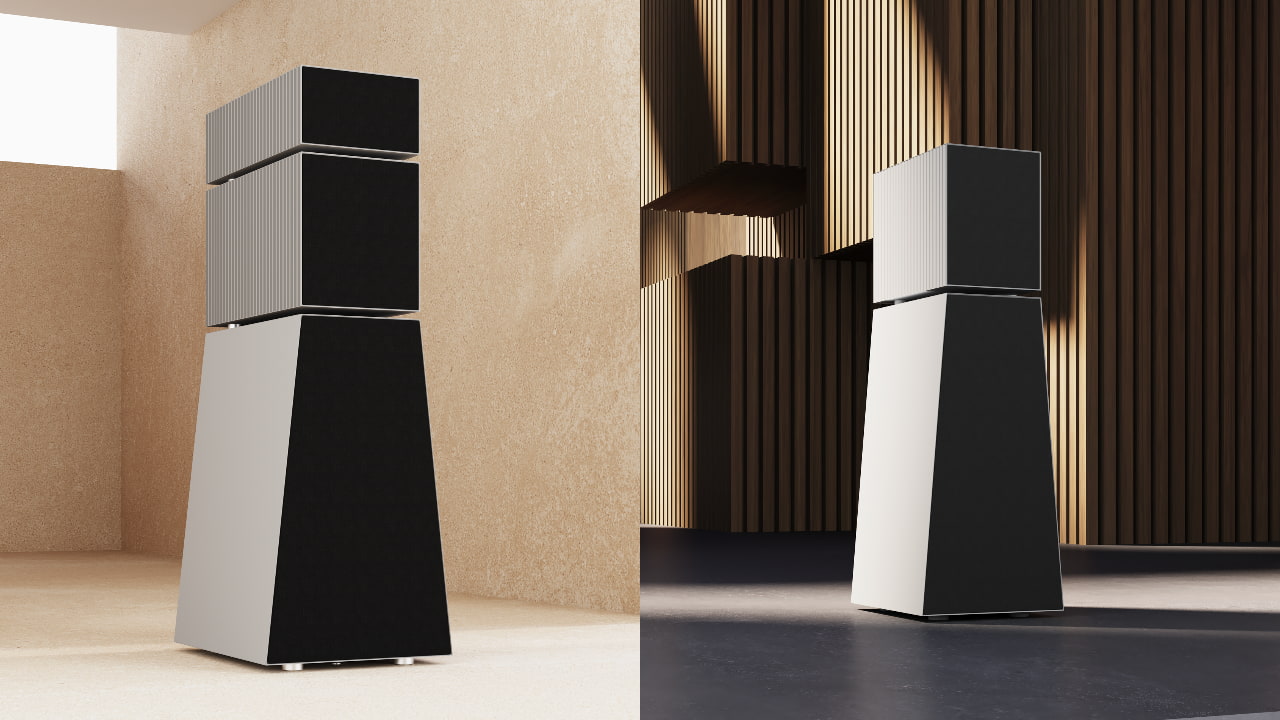
Price & Availability
Both the Goldmund Rhea Passive and Theia Passive are available now—assuming your bank account is ready for a workout.
The Rhea Passive will set you back around $108,000 per pair, which is what some folks spend on a luxury car. The Theia Passive? That one’s closer to $215,000 per pair—because why settle for a condo when you can have speakers instead? These aren’t just loudspeakers; they’re lifestyle declarations… preferably made from the penthouse suite.
Both are available now. We’ll take two of each.
For more information:
- https://goldmund.com/speaker-collection/rhea-passive-stereo-speakers/
- https://goldmund.com/speaker-collection/theia-passive-stereo-speakers/
About Goldmund
Founded in 1978, Goldmund is a Swiss luxury audio brand, situated among the world-renowned watchmakers in Geneva. Goldmund combines exquisite engineering and design to craft showstopper products, including pioneering wireless speakers and exceptional hi-fi separates. From design to technology to authentic performance, Goldmund products are at the top of the game: this is audio art to transform your listening life.
Related Reading

